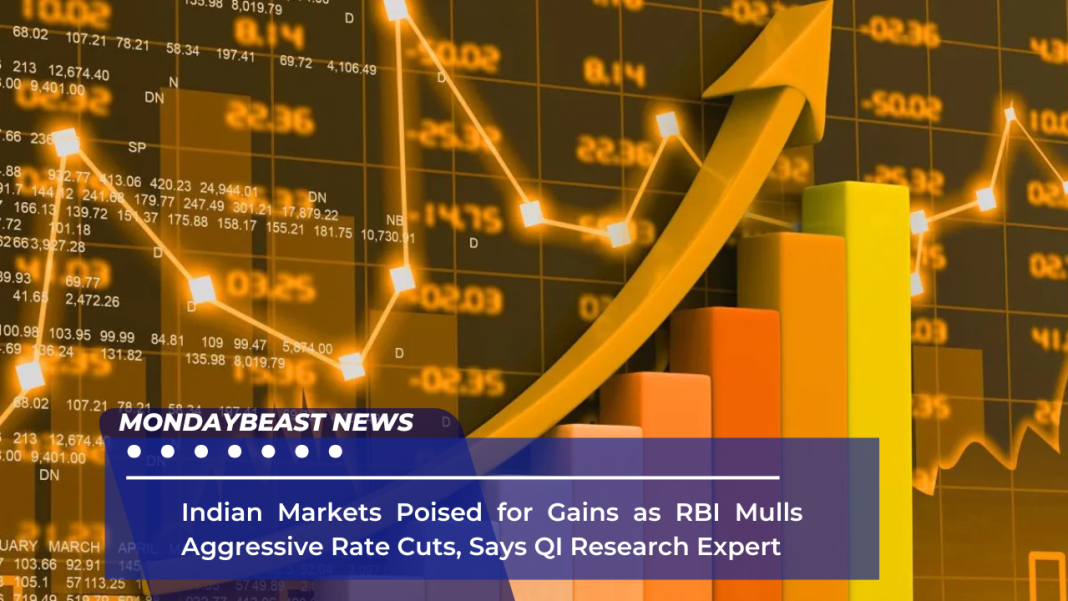Introduction to RBI Rate Cuts
As India’s economy navigates a complex landscape, the Reserve Bank of India’s (RBI) anticipation of aggressive rate cuts stands out. Danielle DiMartino Booth, CEO of QI Research, recently emphasized this potential shift in monetary policy. But what does this really mean for global markets?
Also read
- HEG Shares Soar 30%: The Shocking Move Behind the Surge
- Bitcoin Surges Past $100K: What Trump’s SEC Pick Means for Crypto
- Bitcoin Surges to Over $100,000: Trump’s Impact on Crypto Investment
I often wonder how interconnected our economies truly are. This connection is especially relevant as India—considered an emerging market—prepares to bolster its economic framework. The Reserve Bank of India’s Monetary Policy Committee (MPC) will convene soon.

Their decisions on rate cuts are expected to trickle down into various sectors. Could these cuts bring about a much-needed boost for the Indian markets? Moreover, what implications would this have for investors both in India and abroad? Such questions ignite a curiosity about how the easing of monetary conditions might impact everything from purchase power to investment flows.
India: A Unique Player in Emerging Markets
India is not just an emerging market; it’s a powerhouse in the making. According to Booth, the country enjoys a young and educated workforce. Unlike many developed nations grappling with aging demographics, India’s talent pool continues to grow.
This demographic dividend is a magnet for global companies looking to outsource professional services. Consider an American tech firm outsourcing software development to India. It’s a win-win.

The firm saves costs while benefiting from a skilled workforce. At the same time, Indian workers gain valuable experiences and earnings. It’s this dynamic that keeps India in the spotlight of global economic discussions.
While high valuations in India raise eyebrows, Booth’s insights shed light on its long-term viability. Is it possible to strike a balance between appealing valuations and a thriving economy? This highlights the potential shifts in investment strategies that could come into play as rate cuts materialize.
Concerns Over U.S. Equity Markets
Booth isn’t just optimistic about India; she raises red flags regarding the U.S. equity markets. High valuations may be masking underlying economic challenges. For instance, revisions to key economic data often reveal a different narrative.

The recent downward adjustment of personal income in the U.S. suggests a reality that many investors may find uncomfortable. When massive adjustments like the reduction of personal income by $91 billion occur, how do we interpret the strength of the economy?
These discrepancies in reports spark a prevalent question: Are we, as a society, being misled by favorable headlines? The growth observed might be superficial when viewed against the backdrop of increasing layoffs and rising bankruptcies.
Cryptocurrency’s Role in the Economic Landscape
Taking a turn into the cryptocurrency world, Booth discussed the current surge in bitcoin prices. As digital currencies gain traction, we must ask ourselves: should we trust cryptocurrencies as legitimate economic instruments? With bitcoin breaking the $100,000 mark, it’s become hard to ignore its allure.
Yet, Booth cautions against premature enthusiasm. Bitcoin remains largely a speculative asset, lacking stability as a reliable currency. How many of us, intrigued by the digital currency craze, have stopped to question its true value?
While many thrill at the rapid ascent of bitcoin, others ponder: is it merely a bubble waiting to burst? Reduced regulation could bring about an increase in participation, yet the asset’s appeal seems linked to broader economic trends.
Its popularity echoes a larger sentiment—perhaps a rejection of traditional currencies? The questions continue to multiply, but clear answers remain elusive.
Final Thoughts on Economic Interconnection
As we stand on the brink of significant changes, it becomes crucial to consider the interwoven nature of global economies. The RBI’s moves may not only reshape India’s fiscal landscape but reverberate throughout the world. Can we confidently gauge how these shifts will affect our individual pocketbooks and investment strategies?
The uncertainty of economic forecasts forces us to critically reflect on our positions. Will India emerge as a leader among emerging markets? Only time will tell. Perhaps by paying attention to these shifts, we can better prepare ourselves for whatever lies ahead.




